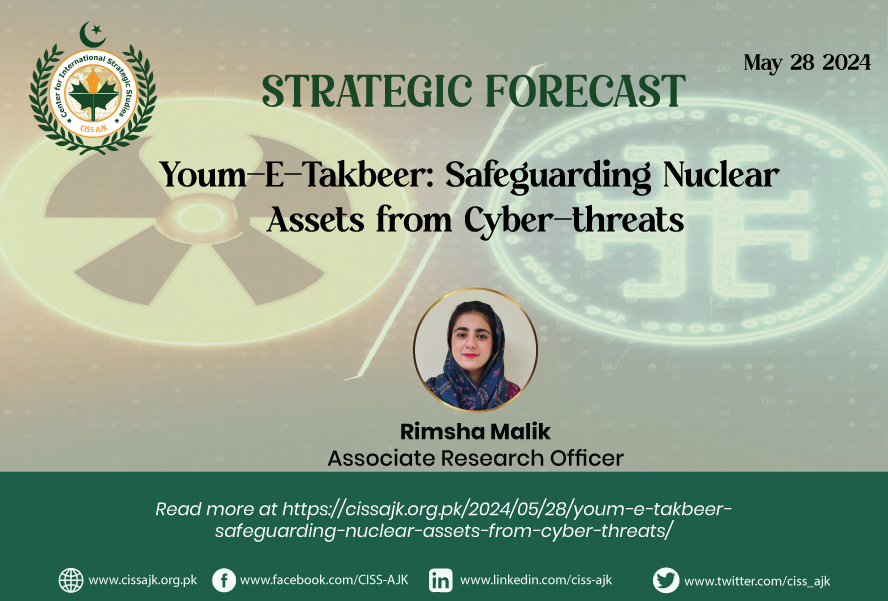“The more connected we get, the more we need to be concerned about security. The more we depend on technology, the more we need to be concerned about its reliability.” – Vint Cerf
Pakistan observes Youm-e-Takbeer on May 28th, honoring the day it became the first Islamic nuclear state in 1998. This achievement represents Pakistan’s dedication to national security and scientific accomplishments. Ensuring the security and resilience of Pakistan’s nuclear assets in the face of growing cyber threats is an urgent issue that needs to be addressed as we commemorate this important day. As evidenced by strict controls and a strong framework, Pakistan’s nuclear program is safe and resilient even in the face of changing cybersecurity threats.
The foundation of a state’s nuclear security policy is its primary responsibility for creating and upholding all-encompassing security measures. As the IAEA’s Fundamental Principle A, the responsibility of formulating, executing, and maintaining a physical protection system rests exclusively on the state. This approach applies to nuclear weapons and their production facilities as well, guaranteeing that resources, information, and weapons are always under legitimate state control. State-specific NC3 systems are essential for integrating nuclear weapons into military operations. Tight civilian supervision, obedience to a highly centralized hierarchy, and physical security against unauthorized usage or explosion are characteristics of effective NC3 systems. Pakistan’s NC3 systems have advanced dramatically since its 1998 nuclear tests, moving from ad hoc to centralized control. Pakistan’s nuclear arsenal is now more secure and dependable due to the increased leadership monitoring of atomic weapons and decreased autonomy of key organizations brought about by this shift.
Nuclear Weapons and Related Systems have been experiencing different cyber threats and cyber-based risks that are exposing society in numerous sectors including the financial sector for the entertainment industry, dept stores, and insurance firms. When it comes to the cyber threats targeting their most strategic networks, governments face an even bigger problem. Vulnerability to cyber-attacks on nuclear weapons or related systems—a nuclear weapon, a delivery system, or the connected (Nuclear Command, Control and Communication) NC3 system––could mean the end of the globe. These consequences could be fake alarm messages, vitiated communication or information sharing, threats to nuclear planning or delivery mechanisms, or even turning a nuclear element into the hands of exploiting forces.
Computer integration into nuclear weapons systems and the possibility of system fault (including induced failure) are long-standing realities. The rise of cyberspace in strategic planning is shown by the national doctrines that most States have created in recent years, which describe their approaches to cyber defense and deterrence. The relationship between cyberspace, military activities, and national security has been clear in several cases. The cybersecurity viewpoints released by the majority of nuclear-armed states are examined in this part, which also describes how cyberspace has been militarised and securitized.
Pakistan has effectively safeguarded its nuclear weapons to a level commensurate with other nuclear-armed powers, but further enhancements are still required. To safeguard the nation’s nuclear resources, Pakistani authorities have taken several steps after the nuclear tests in 1998.
Pakistan formed the National Command Authority (NCA) in 1999 to oversee and protect its nuclear resources. The NCA is made up of the Employment Control Committee (ECC), Development Control Committee (DCC), and Strategic Plan Division (SPD). It was established in 2000 and granted legal recognition in 2007. With its four directorates, the SPD is an essential component of arms control, weapons development, strategic communication, and operational planning. Additionally, it puts into practice the Personnel Reliability Programme (PRP), which verifies the dependability of people who handle nuclear materials. The SPD is also in charge of the Human Reliability Programme (HRP) for military personnel and has the power to look into and punish any questionable behavior.
Strong backup plans are part of Pakistan’s nuclear security protocols to deal with the uninvited removal or sabotage of nuclear material or installations. IAEA Fundamental Principle K requires these plans, which put an emphasis on preventing theft through a variety of controls and routine inspections to guarantee accountability and transparency. A complete security framework also includes radiational detection portal monitors and specific trucks and containers that are impervious to theft. Although the probability of stealing nuclear weapons is low, Pakistan’s civilian Regulation 925 emphasizes how important it is to prepare for security against hostile activities.
Pakistan places greater importance on concealment than overt security measures when it comes to the transportation of nuclear weapons and supplies. Pakistan has made an effort to adhere to the provisions of the Convention on the Physical Protection of Nuclear Materials (CPPNM) ever since it was ratified in 2000. The 2004 Export Control Act, which consolidated earlier laws and imposed severe penalties for infractions, reinforced Pakistan’s nuclear export. To supervise licensing and execution, this Act also established the Strategic Export Control Division (SECDIV).
Significant advancements have been made in building a strong NC3 system and resolving proliferation issues, according to a comprehensive examination of Pakistan’s nuclear security activities during the previous 20 years. A developed nuclear security culture is essential, and efforts are being made in this regard, mostly in the civilian sector. However, government, strategic organizations, regulatory agencies, and civil society must all work together in concert. Despite persistently poor impressions, trust in Pakistan’s nuclear security regime needs to be rebuilt both locally and globally. This requires transparency and self-assessment surveys.

